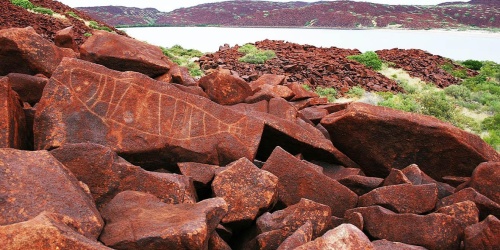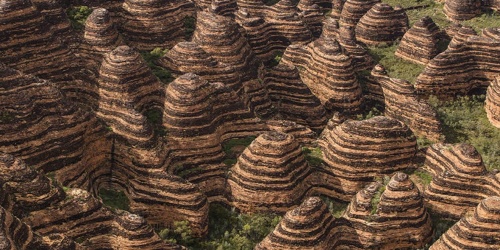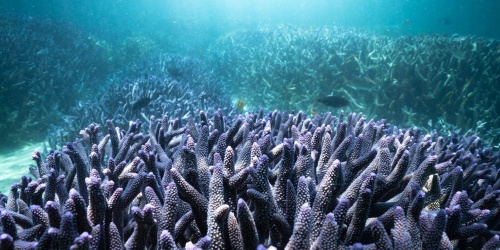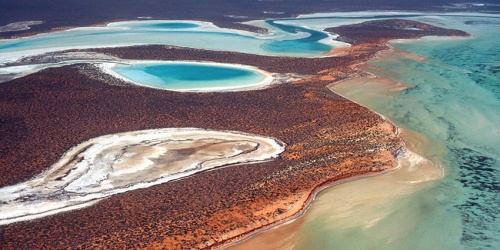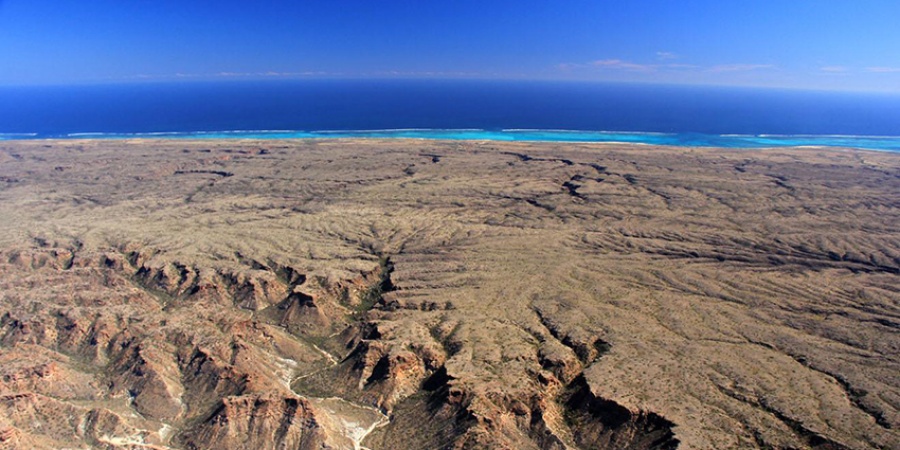
The rugged gorges and wave cut limestone escarpments of Cape Range. Photo by Jen Hollis DBCA
The Ningaloo Coast World Heritage Area covers 604,500 hectares and stretches more than 300km along the remote WA coast. The property includes one of the longest near-shore reefs in the world.
It encompasses the Muiron Islands to the north, the Bundegi and Jurabi coastal parks at the tip of Cape Range National Park, the adjoining Learmonth Air Weapons Range, and Ningaloo Marine Park (which extends up to 22km offshore) and hugs the coastline from the north down to the south near Red Bluff.
The Ningaloo Coast World Heritage Area was inscribed on the World Heritage list on 24 June 2011 under two of the natural World Heritage Outstanding Universal Value criteria:
- containing areas of incredible natural beauty
- containing the most important and significant natural habitats for in situ conservation of biological diversity
The following features are representative of these criteria:
Diverse habitats
- The rare mix of intact, diverse and large-scale terrestrial, coastal and marine habitats form an incredible interconnected ecosystem.
- Habitats include the deep sea, continental shelf, slope and coral reef communities of the Ningaloo Reef; Muiron Islands; coastal, island and estuarine habitats; and the rugged gorges, wave-cut limestone escarpments, terraces, caves and subterranean waters of the Cape Range karst system.
Exceptional natural beauty
- There is a stark and striking contrast between the rugged, arid Cape Range, the sparkling white beaches, and the clear, turquoise colours and underwater scenery of Ningaloo Reef
- The proximity of Ningaloo Reef to an arid continental coast distinguishes it from most reefs in the world which are found associated with wet tropical rainforest habitat.
Ningaloo Reef biodiversity
- One of the longest and most pristine fringing reefs in the world, Ningaloo Reef has an unusually narrow continental shelf. The deep oceanic waters, the reef and coastline communities are in close proximity resulting in a huge array of internationally significant and healthy marine life coexisting in one area.
- More than 200 coral, 500 fish, 650 mollusc, 600 crustacean, 1000 marine algae, 155 sponge and 25 echinoderm species are found on the shelf, slope and deep sea habitats, many of which are new discoveries and endemic to the area.
Whale sharks
- One of the largest, most reliable and best managed whale shark aggregations in the world.
- An estimated 300-500 whale sharks make their way to Ningaloo annually around the time of the mass coral spawning event and seasonal nutrient upwellings.
- 85 percent of the whale sharks that visit Ningaloo are juvenile males (with an average size of 5m).
Mega marine life
- Globally important and threatened mega marine life are also found here including whales, dolphins, manta rays, dugongs, orcas, sharks, turtles and large fish such as tuna and billfish.
- The Ningaloo Coast is a migratory route for humpback whales and other whales. The Exmouth Gulf is an important humpback whale nursery with the highest density in the southern hemisphere.
Turtle nesting
- The Ningaloo Coast is one of the most important turtle nesting rookeries in the Indian Ocean. Three of the world’s seven species of marine turtle mate in the shallows and nest along the Ningaloo coast: the endangered loggerhead turtle, the vulnerable green turtle and the vulnerable hawksbill turtle.
- The coastline provides a large stretch of natural and undisturbed beach suitable for mating and nesting.
Cape Range plants and animals
- Cape Range is a biogeographic transition zone between the tropic, temperate and desert regions, resulting in an exceptionally high diversity of plants, birds and reptiles, a high proportion of which are found nowhere else in the world.
- Reptile species include the Exmouth spiny-tailed gecko, western netted dragon and west coast banded snake
- The area hosts eucalypt woodlands, acacia scrublands and spinifex grasslands. There are more than 630 plant species on the range including the endemic Yardie Morning Glory (Ipomoea yardiensis).
Cape Range karst system
- Under the Cape Range Peninsula lies a complex limestone karst system that is home to a high diversity of unique subterranean fauna. The 535 caves that have been recorded are up to 100m deep and interconnected across 6km.
- More than 80 species of subterranean fauna inhabit these caves with the majority only found within this area. Many display a high level of adaptation to cave life and are pale and have no eyes.
More information
- Ningaloo Coast visitor information
- Ningaloo Coast management
- Ningaloo Marine Park
- Cape Range National Park
- Muiron Islands
- UNESCO World Heritage listing for the Ningaloo Coast
- Download a map of the Ningaloo Coast World Heritage Area below
Ningaloo Coast World Heritage Advisory Committee
Each World Heritage area is overseen by a State Cabinet-appointed advisory committee. These committees provide advice to managing agencies and State and Australian Government ministers to assist in protecting the Outstanding Universal Value of each area.
Find out more about the Ningaloo Coast World Heritage Advisory Committee.
